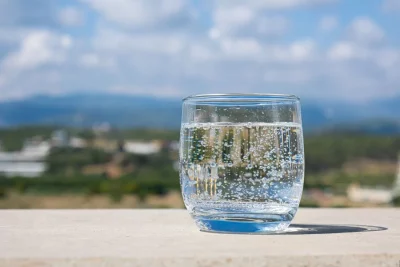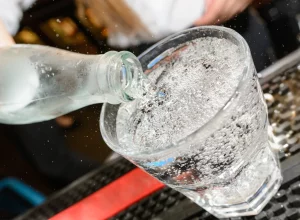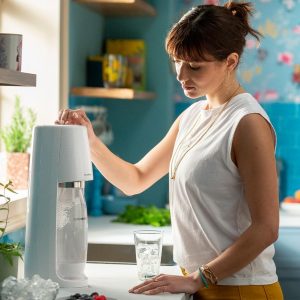Are you tired of plain old tap water? Want to add a little sparkle to your drink without the guilt of consuming sugary sodas? Look no further than carbonated water. With the ease of making carbonate water at home, you can enjoy the fizzy bubbles and enhanced flavors of your favorite drinks without compromising your health.
Carbonating water at home is a simple process that can be done using a few different methods. One of the most popular and convenient methods is using a carbonation machine, which typically comes with a reusable carbonator bottle and a CO2 canister.
These machines can be easily operated with a push of a button, and they will carbonate your water to your desired level. Another method to carbonate water at home is through a DIY setup, which requires a soda siphon and CO2 cartridges.
This method is relatively simple and cost-effective as well. Some people also use a manual carbonator cap for their water bottles to carbonate water with ease; these caps screw onto most standard water bottles and have a small CO2 canister that screws into the cap.
How to make carbonated water at home
There are a few different methods for making carbonated water at home, but the most popular and convenient methods are using a carbonation machine or a DIY setup.
Method 1: Carbonation Machine
- Fill the reusable carbonator bottle with cold water.
- Insert the carbonator bottle into the carbonation machine.
- Attach a CO2 canister to the machine.
- Turn on the machine and select the desired level of carbonation.
- Wait for the carbonation process to complete.
- Remove the carbonated water bottle, and enjoy!
Method 2: DIY Setup
- Fill a soda siphon with cold water.
- Attach a CO2 cartridge to the soda siphon according to the manufacturer’s instructions.
- Shake the soda siphon vigorously for about 30 seconds.
- Release the pressure valve to allow the CO2 to infuse into the water.
- Wait for about 5 minutes for the water to fully carbonate.
- Release the water into a glass and enjoy!
Method 3: Manual Carbonator Cap
- Fill a standard water bottle with cold water.
- Secure the manual carbonator cap to the bottle by screwing it on.
- Insert a small CO2 canister into the cap.
- Use the cap’s trigger to release CO2 into the water bottle.
- Shake the bottle for about 1-2 minutes to allow the CO2 to infuse into the water.
- Release the water into a glass and enjoy!
It’s important to note that carbonated water made at home will not be as effervescent as store-bought carbonated water, and it’s not recommended to make carbonated water for a prolonged period as it will lose its bubbles over time. It’s best enjoyed fresh and cold.
Best equipment for carbonating water at home
There are a variety of equipment options available for carbonating water at home, but some of the best options include the following:
- Carbonation machines: These are stand-alone appliances that allow you to carbonate water quickly and easily. They typically come with a reusable carbonator bottle and a CO2 canister and can be operated with the press of a button. Some popular models include SodaStream, Aarke, and KitchenAid.
- Soda siphons: These are manual devices that use CO2 cartridges to carbonate water. They are portable and can be used to carbonate water on the go. Some popular models include Liss and iSi.
- Countertop carbonators: This type of equipment is designed to sit on a countertop and can be connected to a water line. They use CO2 canisters or tanks to carbonate water. Some popular models include Brilliance and Primo.
- Manual Carbonator Caps: These types of caps have a small CO2 canister that screws into the cap, and it is easily attachable to most standard water bottles.
When choosing the best equipment for carbonating water at home, it’s important to consider the cost, ease of use, and carbonation level you want to achieve. Additionally, some equipment may require more maintenance or need more space than others, and it’s important to take into account all these factors before making a purchase.
Carbonating water at home with a soda stream
Carbonating water at home with a SodaStream is a simple and convenient process that can be done using the following steps:
- Fill the reusable carbonator bottle with cold water. Make sure that the bottle is clean and free from any debris or impurities.
- Insert the carbonator bottle into the SodaStream machine. The machine will have a designated place for the bottle.
- Attach a CO2 canister to the machine. This canister will provide the carbon dioxide needed to carbonate the water.
- Turn on the machine and select the desired level of carbonation. The machine will have a button or lever that controls the amount of carbonation. Start with a lower level of carbonation and add more until you reach your desired level.
- Wait for the carbonation process to complete. This may take anywhere from 20-30 seconds to a minute or two, depending on the machine and the level of carbonation you’ve selected.
- Release the pressure from the bottle by pressing the lever or button designated for it.
- Remove the carbonated water bottle, and enjoy!
- It’s recommended to consume your carbonated water as soon as possible to enjoy the best taste and bubbles, and you can also add some flavor to your water if desired.
With a SodaStream, you can easily make carbonated water at home with the press of a button, and you can make as much or as little as you want, whenever you want it.
The reusable carbonator bottles are a plus, reducing waste and saving money. Be aware that eventually, you will have to replace the CO2 canister, and depending on the use, it may have to be replaced frequently.
Carbonating water at home with a carbonator pump
Carbonating water at home with a carbonator pump involves a few basic steps:
- First, you will need to fill the carbonator pump’s reservoir with cold water. Make sure the water is cold, as carbonating warm water can cause the CO2 to be released too quickly, making the water difficult to control.
- Next, you will need to add CO2 to the carbonator pump. This is usually done by attaching a CO2 canister or connecting a CO2 tank to the pump.
- Once the CO2 is in the carbonator pump, you can begin injecting it into the water. This is typically done by turning a knob or pushing a button on the pump to release the CO2. As the CO2 is injected, it will begin to dissolve into the water, creating carbonated water.
- You can adjust the amount of carbonation by controlling the flow of CO2 into the water. More CO2 will create a higher level of carbonation, while less CO2 will create a lower level.
- Once you have achieved the desired level of carbonation, you can pour the carbonated water into bottles or glasses and enjoy it.
It’s important to follow the manufacturer’s instructions when using a carbonator pump, as improper use can be dangerous. You should also take care to handle the CO2 canisters or tanks properly to avoid accidents.
By using a carbonator pump, you will able to make carbonated water at home, and it’s a great way to enjoy sparkling water without having to buy it pre-carbonated.
Carbonating water at home with dry ice
Carbonating water at home with dry ice is a process of adding carbon dioxide (CO2) to water to create carbonated water or soda water. Dry ice is solid CO2, which can be used to carbonate water by adding it directly to the water. This method can be less convenient than using a carbonator pump, as dry ice can be difficult to handle and store.
The process of carbonating water with dry ice is as follows:
- Start by placing cold water in a container that can be sealed tightly. Make sure the water is cold, as carbonating warm water can cause the CO2 to be released too quickly, making the water difficult to control.
- Carefully add small pieces of dry ice to the water. Be sure to wear gloves and safety glasses when handling dry ice, as it can cause frostbite.
- Seal the container tightly and shake it gently to help the dry ice dissolve into the water.
- The carbonation process will happen quickly, and you need to be careful not to over-carbonate the water, as this can make it difficult to control. You can adjust the amount of carbonation by controlling the amount of dry ice added to the water.
- Once you have achieved the desired level of carbonation, you can pour the carbonated water into bottles or glasses and enjoy it.
It’s important to use dry ice only in well-ventilated areas and keep it out of reach of children and pets, as it can be dangerous. You should also take care to handle the dry ice properly to avoid accidents.
The dry ice method can be a bit more challenging compared to the carbonator pump, and it’s also less efficient as dry ice sublimates quickly, and handling it can be tricky. It’s not recommended to use it frequently.
Pros and cons of carbonating water at home
Pros:
- Convenience: Carbonating water at home allows you to enjoy sparkling water whenever you want without having to buy it pre-carbonated.
- Customization: You can control the amount of carbonation in your water, allowing you to make it as bubbly or as mild as you like.
- Cost-effective: Carbonating water at home can be more cost-effective than buying pre-carbonated water, especially if you are able to purchase CO2 in bulk.
- Environmentally friendly: Making your own carbonated water at home can reduce the need for single-use plastic bottles, which can be an environmentally friendly choice.
Cons:
- Equipment: Carbonating water at home requires some equipment, such as a carbonator pump or dry ice, which can be costly and take up space.
- Safety: Carbonating water at home can be dangerous if not done properly, as the CO2 canisters or tanks can be pressurized and may explode if handled incorrectly.
- Time-consuming: Carbonating water at home can take a little more time than simply buying pre-carbonated water.
- waste generation: Carbonating water at home will generate some waste, such as CO2 canisters, tanks, or dry ice.
Flavorings for carbonated water at home
Flavorings can be added to carbonated water at home to create a variety of delicious and refreshing drinks.
One popular method is to add fruit juice or syrups to carbonated water. This allows you to create your own homemade soda flavors, such as lemon-lime, orange, or strawberry. Fruit juices or syrups can be added to carbonated water in any proportion to create the desired flavor and sweetness level.
Another method is to add herbs, such as mint, basil, or cucumber, to carbonated water. This can add a fresh and unique taste to your carbonated water.
You can also infuse your carbonated water with flavors like honey, cinnamon, or vanilla. You can use extracts or essence of these flavors or naturally infusion of them with hot water or by leaving the ingredients in the water overnight.
A more healthy approach is using real fruits, veggies, or herbs. You can blend them and add them to your carbonated water.
It’s important to note that when using flavorings, you should use natural ingredients and avoid using artificial flavors or sweeteners, which can be unhealthy. You can experiment with different flavorings and ratios to find the combination that you like the best.
You can even customize the flavorings by experimenting with different fruits, vegetables, and herbs and find the perfect balance of flavors and sweetness to suit your taste.
Cost comparison of store-bought vs homemade carbonated water
The cost comparison between store-bought carbonated water and homemade carbonated water can vary depending on the method used to carbonate the water and the cost of ingredients and equipment.
Store-bought carbonated water can be purchased in bottles or cans, and the cost can vary depending on the brand and the size of the container. On average, a liter of store-bought carbonated water can cost around $1 to $2, depending on location and tax.
Homemade carbonated water can be made using a carbonator pump or dry ice. The cost of a carbonator pump can vary, with prices starting at around $50, and can go up depending on the features and quality of the pump.
CO2 canisters or tanks are needed to run the pump, and the cost of these can also vary. Once the equipment is purchased, the cost of carbonating water at home can be relatively low, as the primary cost is for the CO2 canisters or tanks, which can be purchased in bulk and refilled for a lower cost per liter.
If you’re using the dry ice method, it can be less cost-efficient as dry ice is more expensive than CO2 canisters and tanks. It also sublimates quickly, and handling it can be tricky.
Adding flavorings to homemade carbonated water can also add to the cost, as the ingredients used can vary in price. Using natural ingredients can be cheaper than using artificial flavorings.
Overall, the cost of homemade carbonated water can be less than store-bought carbonated water, especially over time once the equipment is purchased and refilled; however, it can also vary depending on the method and ingredients used.
Safety precautions for carbonating water at home
Carbonating water at home can be a fun and enjoyable process, but it’s important to take safety precautions to avoid accidents.
When using a carbonator pump:
- Always read and follow the manufacturer’s instructions carefully. Improper use of the pump can be dangerous.
- Make sure that the CO2 canisters or tanks are securely attached to the pump before turning it on.
- Use the pump in a well-ventilated area to avoid the buildup of CO2.
- Keep the pump away from heat sources, such as stoves or ovens, as high temperatures can cause the CO2 canisters or tanks to overheat and potentially explode.
- Handle the CO2 canisters or tanks with care, as they are pressurized and can explode if punctured or damaged.
- Make sure that the pressure release valve is functioning properly and in good condition.
- Keep the pump out of reach of children and pets, as it can be dangerous if not used properly.
When using dry ice:
- Dry ice is extremely cold and can cause frostbite, so it is important to handle it with gloves and safety glasses.
- Keep dry ice away from the skin and eyes and handle it in well-ventilated areas.
- Keep it out of reach of children and pets.
- Be careful when handling dry ice, and do not ingest it; it can be dangerous.
- Use dry ice only in well-ventilated areas.
When adding flavorings:
- Only use natural ingredients and avoid using artificial flavors or sweeteners, as they can be unhealthy.
- Be careful when handling any equipment or ingredients that may cause injuries, such as knives or blending machines.
In general, it’s important to use common sense and be aware of the potential hazards when carbonating water at home. Following the manufacturer’s instructions and taking appropriate safety precautions will help ensure that the process is safe and enjoyable.
Can you carbonate tap water at home?
Yes, you can carbonate tap water at home using a carbonator pump or dry ice method. However, it’s important to note that tap water can contain impurities, such as chlorine and other chemicals, which can affect the taste of the carbonated water.
If you want the best-tasting carbonated water, it is recommended to use filtered or purified water instead of tap water.
If you’re going to use tap water, it’s important to ensure that it is safe to drink. If you have any concerns about the safety of your tap water, it’s best to have it tested. You can also consider investing in a water filter or purification system to remove impurities before carbonating the water.
It’s also worth noting that when carbonating tap water, it’s better to use cold water, as carbonating warm water can cause the CO2 to be released too quickly, making the water difficult to control.
Generally, it is possible to carbonate tap water at home, but it’s recommended to use purified or filtered water for best results and to keep it cold. Also, considering the water quality from your faucet, if it’s not suitable for drinking, then it’s not suitable for carbonation.
How to adjust the carbonation level in homemade carbonated water
Adjusting the carbonation level in homemade carbonated water can be done by controlling the amount of CO2 that is added to the water.
When using a carbonator pump:
- The carbonation level can be adjusted by controlling the flow of CO2 into the water. More CO2 will create a higher level of carbonation, while less CO2 will create a lower level.
- This can be done by turning the knob or adjusting the settings on the carbonator pump to control the amount of CO2 that is injected into the water.
- Carbonating the water for a longer period of time will also add more carbonation, but this also depends on the pressure and temperature of the water you’re carbonating.
- Be sure to follow the manufacturer’s instructions for your specific carbonator pump to ensure that you are using it correctly and safely.
When using dry ice:
- The carbonation level can be adjusted by controlling the amount of dry ice added to the water. More dry ice will create a higher level of carbonation, while less dry ice will create a lower level.
- You can start with a small amount of dry ice and then add more to achieve the desired level of carbonation.
- The carbonation process happens quickly with dry ice and you need to be careful not to over-carbonate the water, as this can make it difficult to control.
- You can test the carbonation level by pouring a small amount of water into a glass and checking the number of bubbles present.
Overall, controlling the carbonation level in homemade carbonated water is a process of trial and error. You can start with small amounts of CO2 or dry ice and gradually increase the amount until you reach your desired level of carbonation.
Be sure to pay attention to the water temperature, pressure, and ingredients added to the water, as they can influence the carbonation level.
Recommended:
- How much alcohol is in modelo?
- How much alcohol is in Hennessy?
- How many shots in a bottle of vodka?
Conclusion
Carbonated water, also known as sparkling water or soda water, is water that has been infused with carbon dioxide gas under pressure. This creates the characteristic “fizz” that is associated with carbonated beverages.
You can make carbonate water at home using a carbonation system, such as a soda maker, or by adding carbon dioxide to still water using a canister or a CO2 tank. While carbonated water is not a significant source of nutrition, it can be a refreshing alternative to plain water and can be used as a mixer for alcoholic beverages.
It is important to note that some carbonated water can contains added sugar and artificial ingredients, so it’s always a good idea to read the label before purchasing.



